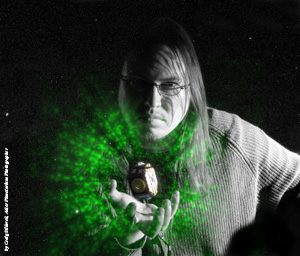Patrick McPike

In March 2009, the Adler Planetarium in Chicago, Illinois will be proud to host the world premiere public opening of IBEX: Search for the Edge of the Solar System, a new digital planetarium show about the Interstellar Boundary Explorer mission and the science behind it. This month, meet Patrick McPike, one member of the Adler's IBEX show production team.
Patrick McPike grew up in Alton, Illinois, a town of 30,000 residents located just north of St. Louis, Missouri along the banks of the Mississippi River. Art has always been on Patrick's mind. When he was a child, he loved to draw and thought that one day he would work for Walt Disney. Around age seventeen, drawing became less of a focus and he delved deeply into many different fine arts such as watercolors, oil painting, and other forms of drawing. Patrick says, "I thought I was going to follow a career in fine art but soon realized that it was hard to make a career in that. About that time computer animation was starting to take off. It was a great choice for me. I could use my fine art skills and still pay the bills. I graduated with a Bachelor of Fine Arts in Media Arts and Animation from the Illinois Institute of Art in Schaumburg, Illinois. I was quickly hired at the Adler. I had always enjoyed astronomy and had even taken some college courses on the subject, so I felt I would fit right in producing content for the field."
Currently, Patrick is a Senior Animator and 3D Artist in the Art Department at the Adler. Planetarium show production has evolved in the past decade or so from the realm of photo slides and mechanical special effects to quickly include computer animation. In the case of IBEX: Search for the Edge of the Solar System, the show involves a blend of computer animation and live action scenes. A typical day for Patrick is a fascinating look into this creative digital world:
"Each day, I come into the office and sit at my computer and get to work. When we start a piece or a show, the team usually divides the work based on our strengths. I am more of the technical animator and artist in the group. I take a lot of the scenes that have particle work, which is the process of creating animations that are driven by points or particles, such as things that behave in an abstract way like smoke, fire, water, explosions, gas, clouds, etc. For this type of work you set a group of rules, and then the objects follow these rules to produce the effect you are looking for. Someone else may paint or colorize textures for objects in the show. I think that is a little ironic because I am the one with the fine arts background! I guess you could say that I do tasks that may not be as much fun to do individually, but my reward is that the scenes look great when they are done because of all of the hard work along the way. For the show, I have been working mainly on creating a 3D Sun and working on timing for the scenes. I also oversee a lot of everyone else's work for quality control. I have to make sure that the scenes flow and match.
"It's rare that I finish a project before I go home at night, so when I come in the next day, I usually just start where I left off on something. You could describe it like leaving work in mid-sentence only finish what you were saying first thing the following morning."
As all of the Monthly Highlight interviewees are asked, Patrick has short and simple advice for those seeking to enter the highly competitive world of computer animation: "My advice would be to never settle for less." Computer animation is a rapidly advancing field. Patrick was surprised that animation had so much math and timing in it. "Everything we do in show production, such as audio, animation, and video work, has to be timed out to the exact frame," he says. "In computer animation is typically 30 frames per second. You can imagine how annoying it is if you discover you're off on timing by just one second!"
Patrick dreams of creating a show that is inspiring and entertaining beyond what's out there right now. "Most of the time, when you watch a recent sci-fi movie you think, 'wow that's cool' - but it's not really inspiring. 2001: A Space Odyssey was probably the most inspiring movie yet, and if I'm lucky, I will create something one day that could be considered in that realm."
Patrick is currently finishing his Master of Fine Arts degree from the Academy of Art in San Francisco and hopes to graduate in early 2010. His hobbies include movies, video games, art and music. "Right now I'm on a classic sci-fi movie binge," he exclaims.
He says that the best part of his job is seeing the general public enjoy the artwork that he creates for the Adler. He says, "Check out the show when it's finished. We really tried to make it something fun to watch while you learn about the mission." The IBEX team hopes that people all over the country will, too, as the IBEX show is distributed to other planetaria in the near future.